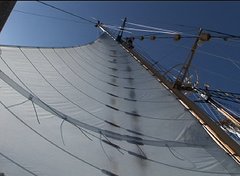 |
| A
yellowfin tuna finning at the surface, swimming right. The second dorsal fin sweeping back and the top of the caudal (tail) fin visible. |
We made one pass through the school of Yellowfin tuna, exclaiming as we saw them finning at the surface. The view from aloft was incredible – Hannah and Andreas acted as spotters, watching for the most tuna activity and guiding the ship. As the sun sank lower in the horizon, we motored through the school three more times, watching these breathtaking creatures do what they do best – hunt.
But we were also on the hunt. While I think I would have been happy with this gorgeous view regardless of a catch, there was also science to be done, and a salivating crew. I study tuna biomechanics – what gives these fish their swimming power, efficiency, agility, grace? Specifically on this cruise, I’m interested in the tail joint, tendons, and driving muscle groups. And so, for the time being, the SSV Robert C. Seamans turned fishing vessel.
On our fifth pass through the school, professor Barb Block called out, “Alright, one last try here.” A moment later, just as the sun touched down on the horizon, a shout went up from the quarterdeck – we had a hit! Nick seized the fishing rod, and a record struggle began, rod arching and spool singing. Night falling, Ryan switched in, followed by Robbie as we launched the small boat with Jan, Ethan, and Ryan. Several hours and sweat-soaked shirt later, Robbie stepped down to Nick. Ryan came back aboard and Robbie joined the small boat, and relieved Nick. Don took a turn. Nick picked it up once more. What a fish, to fight us for five hours, well into the darkness, and through seven shifts of fishermen!
 |
| The
prize catch- the largest yellowfin ever landed on the RCS |
Peace, love, and fish tales/tails,
-
UPDATE: post-dissection leftovers GLOW! WHAT? – will be investigating. This fish just keeps surprising us!


2 comments:
Sounds like you are having a better time then ever was expected. Congratulations on the perfect tuna for you to study, that is absolutely amazing. Good luck on the dissection, I'm cheering for you guys. Happy fishing and smooth sailing. My best wishes to Marina and everyone on the Bobby C.
NICE FISH! Tight Lines
Post a Comment